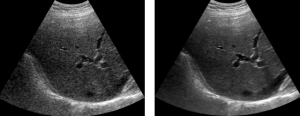by
Brendon Nafziger, DOTmed News Associate Editor | April 11, 2011

Ultrasound view of
the liver, unenhanced
vs. enhanced.
(Photo courtesy
ContextVision)
Image enhancement software could make ultrasound scans of obese patients clearer.
ContextVision is set to unveil the new technology, US PLUSView, at the American Institute of Ultrasound in Medicine's annual conference in New York this week.
"The problem with ultrasound is it doesn't have much penetrating energy, so when you're trying to [scan] a pregnant woman or an American who is rather obese, which is a lot of us, ultrasound can't give you the kind of diagnostic detail that you'd like to have," Donald Barry, director of commercial development with ContextVision, told DOTmed News.
Around one-third of Americans are obese, according to statistics released last month by the Centers for Disease Control and Prevention.
ContextVision's technology is being sold in three "modules" that can be upgraded by buying new licenses. The normal version, US PLUSView, is an updated version of the 28-year-old company's earlier GOPView technology, with better noise reduction, Barry said. The "advanced" module features adaptive filtering and better resolution. And "premium" features a new technique called directed, focused enhancement, which lets the operator enhance one area of an image -- such as the liver of an obese patient. "This is new to the industry," Barry said.
As with the rest of ContextVision's products, the new technology is sold directly to OEMs to put "under the hood" of their equipment. For the directed, focused enhancement, this could take the shape of a one-button set-up, where a radiologic technologist or radiologist would press a button for, say, "obese patient liver," and then the program would automatically fill in the required settings, Barry said.
Barry said the proposed first ship date is June 1. The company also has clinical tests in the works, and plans to work through the next six to nine months on a paper.
But sonographers can see it in action this week at
AIUM's annual conference, which runs from April 14-17 at the Marriott Marquis in New York.
